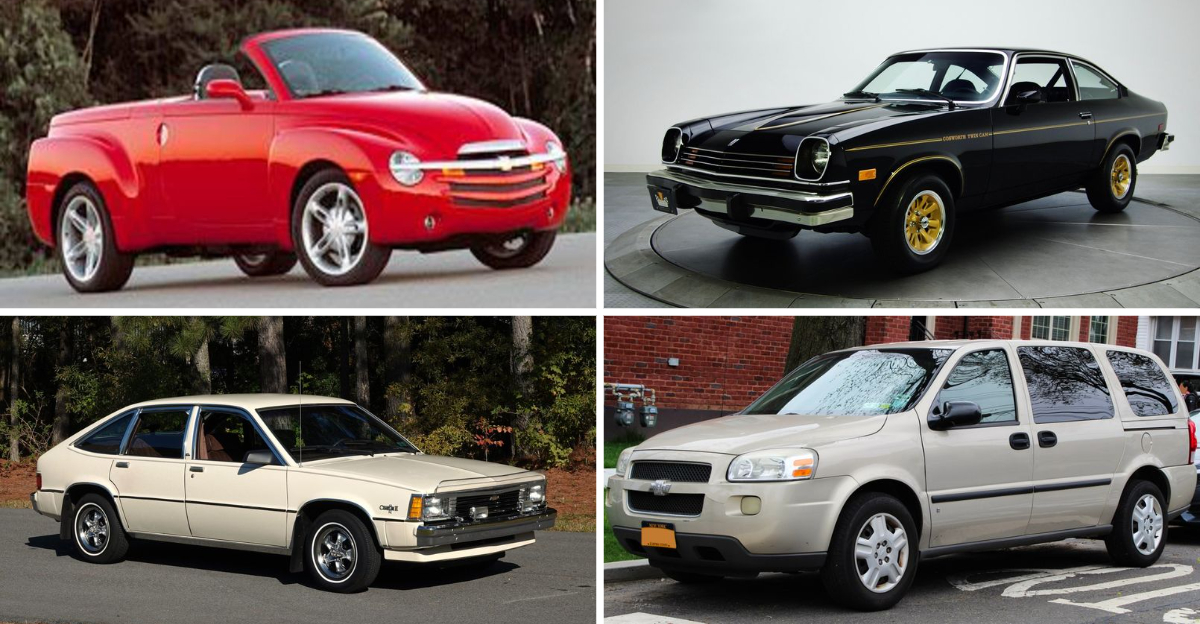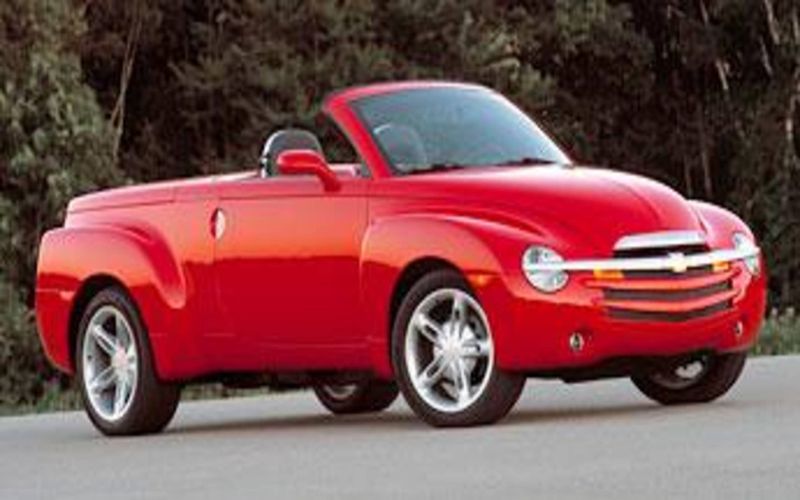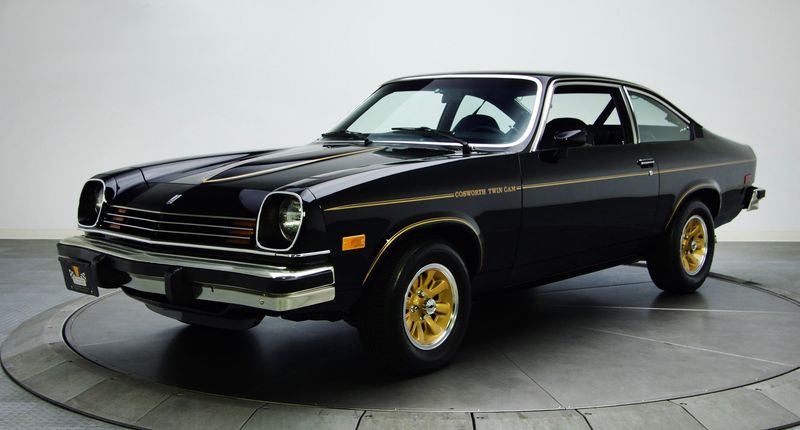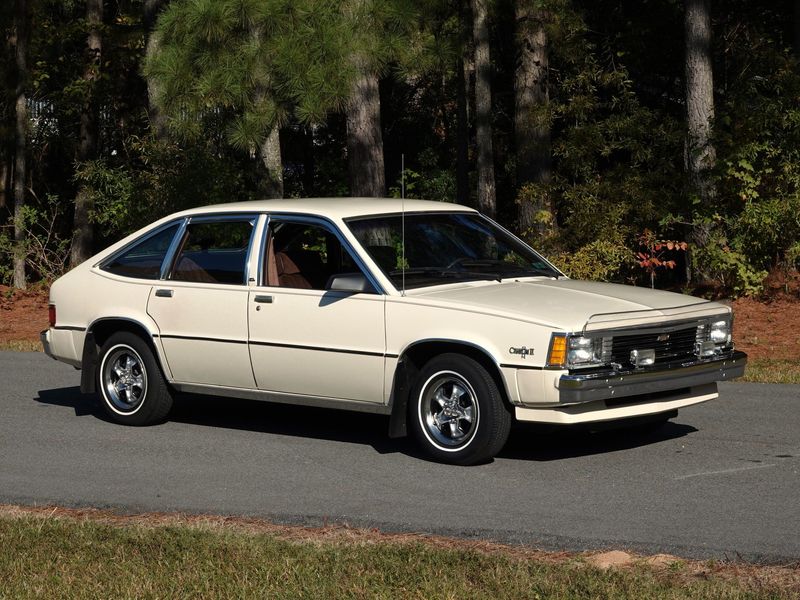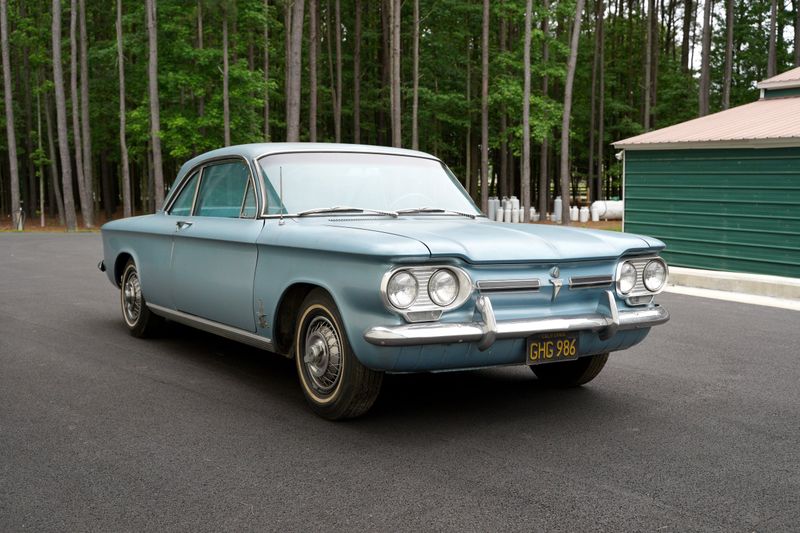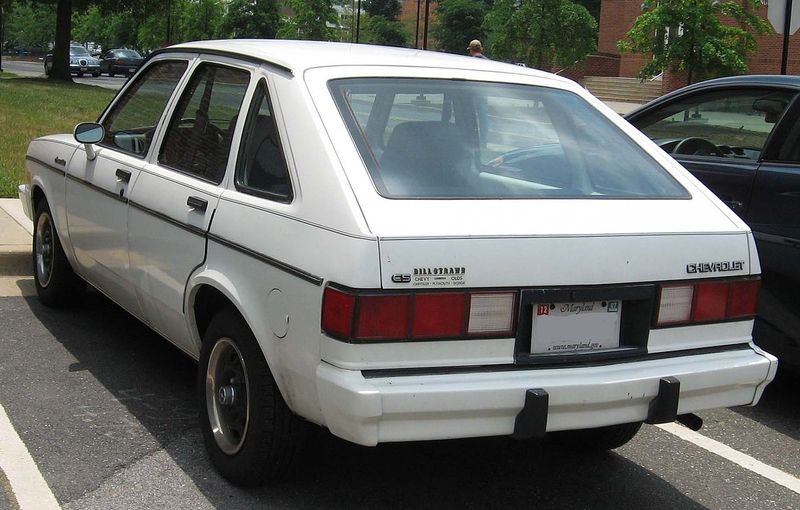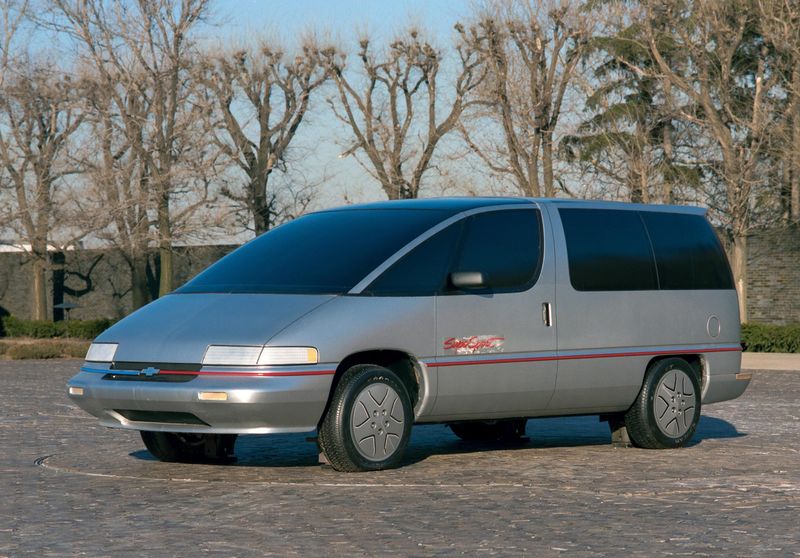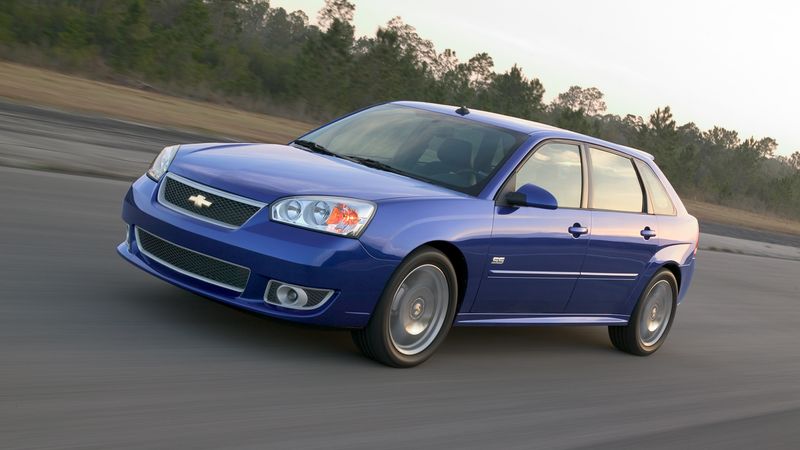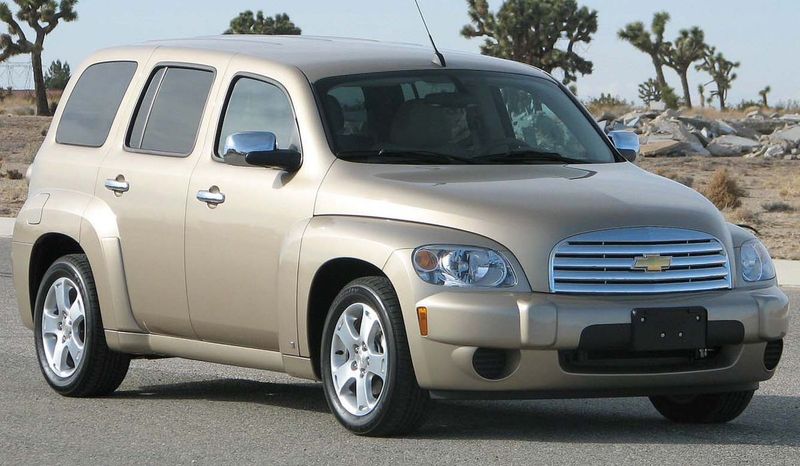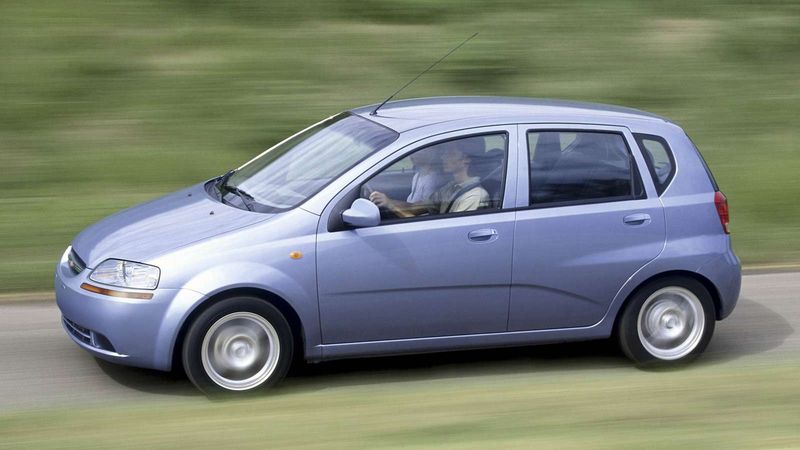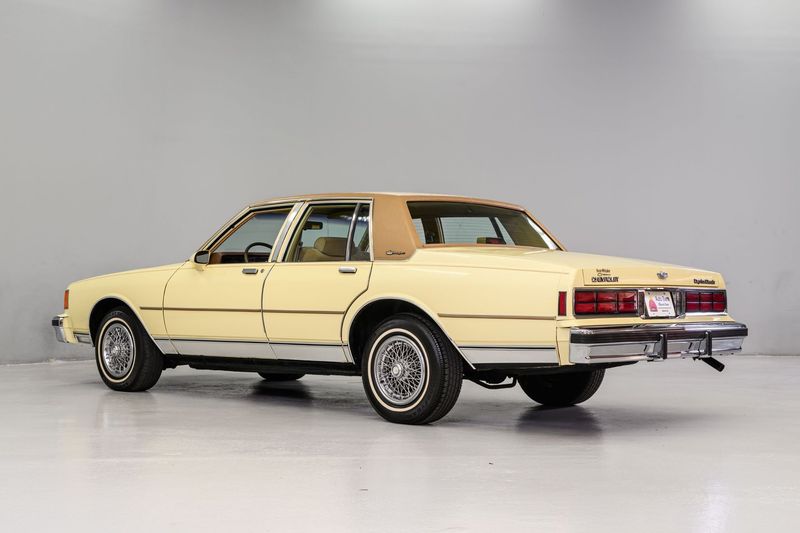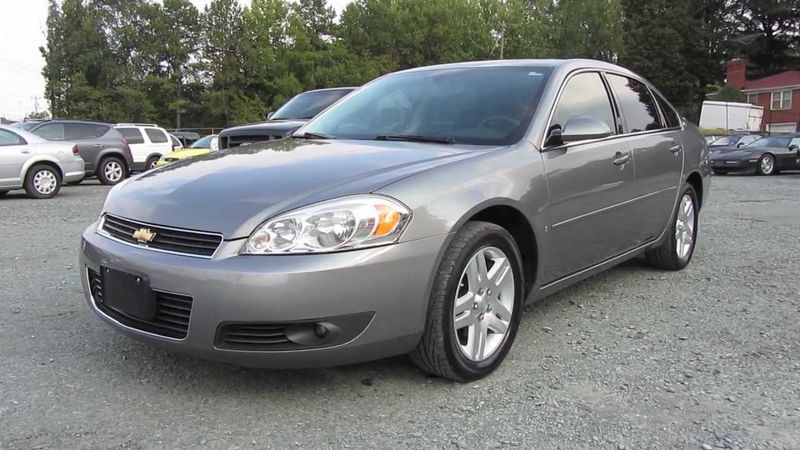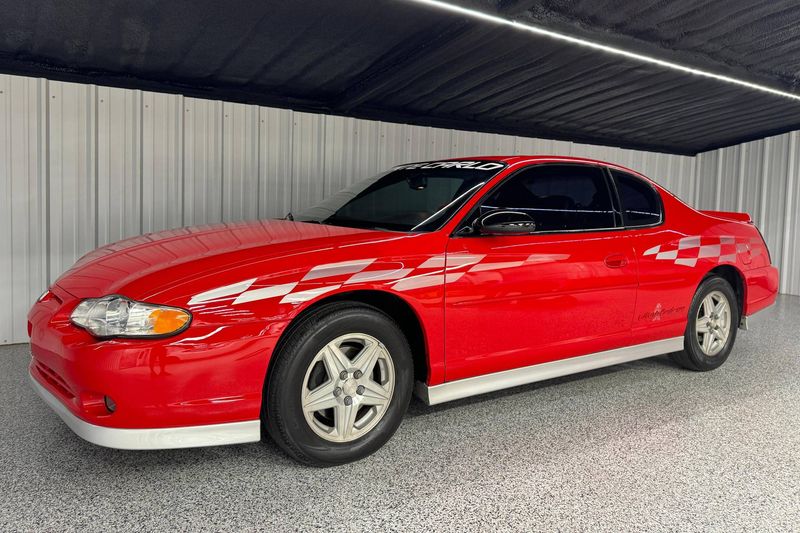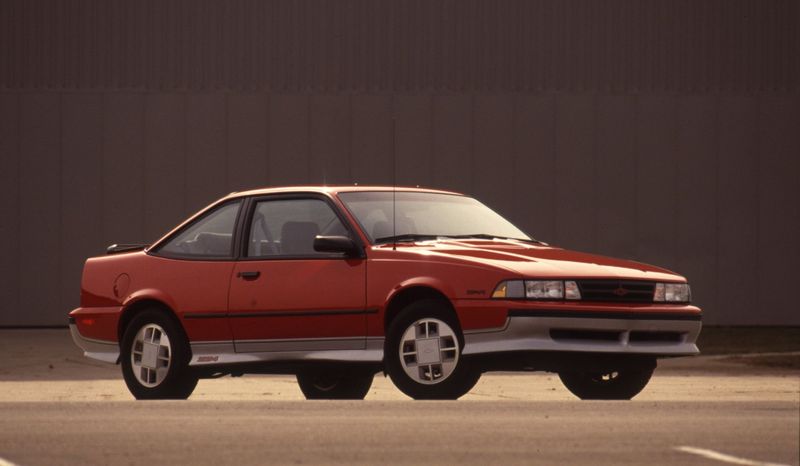📖 Table of Content:
- 1. Chevrolet SSR
- 2. Chevrolet Vega
- 3. Chevrolet Citation
- 4. Chevrolet Corvair
- 5. Chevrolet Uplander
- 6. Chevrolet Chevette
- 7. Chevrolet Lumina APV
- 8. Chevrolet Malibu Maxx
- 9. Chevrolet HHR
- 10. Chevrolet Aveo
- 11. Chevrolet Caprice Classic
- 12. Chevrolet Impala (2006)
- 13. Chevrolet Monte Carlo (2000s)
- 14. Chevrolet Tracker
- 15. Chevrolet Cavalier
Chevy has had its share of iconic designs, but not every model hit the mark. Over the decades, some Chevys have stood out for all the wrong reasons, becoming infamous for their less-than-appealing aesthetics. This list explores 15 of those models, examining why their designs missed the mark and how they fit into automotive history. Whether due to misguided styling choices or unfortunate trends of the era, these cars serve as interesting lessons in design missteps.
1. Chevrolet SSR
Introduced in 2003, attempted to blend a convertible with a pickup truck. Its retro-futuristic design aimed to capture nostalgia, but its look was confusing. The oversized wheel arches and bulbous shape made the SSR seem out of place. Inside, the interior was cramped and didn’t match the outward styling. Though it featured a powerful V8 engine, its heavy weight compromised performance. The SSR’s design didn’t resonate with consumers, leading to lackluster sales. Today, it’s remembered more for its peculiar appearance than its engineering feats, serving as a reminder of risks in automotive design.
2. Chevrolet Vega
Launched in the 1970s as a compact, economical car. Initially praised for its style, it faced severe criticism over time. The sleek design was overshadowed by significant issues like rust and engine reliability. Its aluminum engine block was innovative but problematic, leading to frequent breakdowns. The Vega’s appealing design couldn’t compensate for its mechanical failures. Over time, rust became a defining feature, tarnishing its reputation further. The Vega’s legacy is a cautionary tale about balancing aesthetics with engineering, highlighting the importance of reliability in automotive design.
3. Chevrolet Citation
Introduced in 1980, the Chevrolet Citation marked a shift to front-wheel drive. Its boxy design was typical of the era but lacked flair. While it offered interior space and practicality, the aesthetic was uninspiring. The Citation also suffered from quality control issues, tarnishing its image further. Its plain exterior failed to capture the public’s imagination, causing it to struggle in the competitive market. Though it sold well initially, its reputation quickly declined. The Citation stands as a reminder that practicality must be matched with appealing design to achieve lasting success in the automotive industry.
4. Chevrolet Corvair
Produced in the 1960s, is infamous for its design flaws. Its rear-engine layout led to handling issues, overshadowing its sleek look. The styling was streamlined and modern for its time, yet safety concerns made it notorious. Ralph Nader’s book “Unsafe at Any Speed” highlighted these flaws, impacting the Corvair’s legacy. Despite its attractive appearance, its reputation suffered. The Corvair is a classic example of how design innovation must be paired with safety. It remains a topic of discussion in automotive circles, showcasing the fine line between innovation and practicality.
5. Chevrolet Uplander
The Chevrolet Uplander, introduced in 2005, was a minivan that struggled to compete in a crowded market. Its design lacked originality, appearing uninspired and bland. The Uplander’s styling did little to set it apart from competitors, resulting in lackluster sales. Inside, the interior felt outdated even at launch, failing to impress families seeking modern features. Despite its practical aspects, the Uplander’s uninspired look was a major drawback. It serves as an example of how crucial compelling design is, even in practical vehicles. The Uplander is often remembered for its unremarkable design rather than its utility.
6. Chevrolet Chevette
Popular in the 1980s, was a compact car that prioritized economy over style. Its design was basic, with little effort to stand out visually. The Chevette’s boxy shape and uninspired aesthetics were emblematic of budget cars of its time. While it offered affordability and fuel efficiency, its look was forgettable. The interior was sparse, reflecting its economical purpose. Though it served its function, the Chevette’s lack of visual appeal is a reminder that even budget cars benefit from thoughtful design. It remains a symbol of practicality over style in automotive history.
7. Chevrolet Lumina APV
Launched in the 1990s, featured a futuristic design that didn’t resonate with buyers. Its sloped front and angular body were ahead of its time but appeared awkward. The plastic body panels and unconventional lines made the minivan stand out—unfavorably. Despite offering space and practicality, the Lumina APV’s look was polarizing. The interior, though spacious, lacked modern amenities. This model’s failure highlighted the risks of venturing too far from design norms. It serves as a cautionary tale in balancing innovation with consumer expectations in the automotive world.
8. Chevrolet Malibu Maxx
Introduced in 2004, was a hatchback that struggled with its identity. Its design blended sedan and hatchback features, resulting in a confused aesthetic. While practical, its look was awkward and unappealing. The rear end’s bulky appearance clashed with the sleek front, highlighting the design disconnect. Inside, space was a plus, but the interior design was lackluster. The Malibu Maxx’s mismatched styling failed to attract buyers, reflecting the importance of cohesive design. It stands as a reminder that practicality must be paired with an appealing look to succeed in the market.
9. Chevrolet HHR
The Chevrolet HHR, introduced in the mid-2000s, sought to capitalize on retro styling. Its design echoed the 1940s Suburban, but the execution was polarizing. The HHR’s high roofline and round fenders gave it a distinct look, but one that not everyone appreciated. While it offered utility, its aesthetics were divisive. The interior continued the retro theme, which wasn’t universally loved. Though it had its fans, the HHR’s design limited its appeal, impacting sales. This model illustrates the challenge of blending nostalgia with modern design, underscoring the need for broader stylistic appeal in the automotive market.
10. Chevrolet Aveo
A subcompact introduced in the 2000s, aimed to offer affordability and efficiency. Its design was basic, with a generic shape and lackluster styling. While it served its purpose as an economical city car, it failed to excite visually. The interior offered minimal features, reinforcing its budget status. Despite its practical benefits, the Aveo’s design was seen as dull and uninspired. This model serves as a reminder of the importance of design even in budget segments. Its legacy is one of practicality overshadowed by forgettable aesthetics, highlighting the need for balance in design and function.
11. Chevrolet Caprice Classic
The Chevrolet Caprice Classic of the 1990s was known for its large, boxy design. While it exuded presence, its aesthetic was outdated compared to rivals. The Caprice’s bulky profile and simplistic lines seemed suited for another era, failing to capture modern buyers’ attention. Inside, the interior was spacious but lacked design innovation. This model’s failure to evolve stylistically is a lesson in keeping up with consumer preferences. Despite its robust performance, the Caprice Classic’s look didn’t resonate, illustrating the need for continuous design evolution. It remains a symbol of the challenges faced when tradition clashes with modernity.
12. Chevrolet Impala (2006)
Aimed to modernize the classic sedan, but its design fell short of expectations. The exterior was bland, lacking distinctive features. While it provided comfortable seating and a smooth ride, its appearance was uninspiring. The design failed to captivate buyers, contributing to its declining popularity. Inside, the interior was functional but dull, with minimal innovation. This model underscores the importance of aesthetics in maintaining a brand’s legacy. Despite its capabilities, the Impala’s lack of visual appeal hindered its success, serving as a reminder that innovation needs to encompass both engineering and design.
13. Chevrolet Monte Carlo (2000s)
Tried to blend sporty performance with stylish design. While the idea was commendable, the execution was lacking. Its chunky body and awkward proportions didn’t match its performance aspirations. The design seemed out of sync with its intended sporty image. Inside, the interior struggled to balance style with functionality, leaving much to be desired. The Monte Carlo’s failure to align design with its sporty ambitions highlights the importance of cohesive branding. This model remains a lesson in ensuring that design and performance work in harmony to meet consumer expectations.
14. Chevrolet Tracker
A compact SUV from the 1990s, aimed for a rugged look but ended up appearing outdated. Its boxy shape and simplistic design didn’t age well, making it less appealing over time. While it offered off-road capabilities, its aesthetic was uninspired. The interior was functional yet basic, lacking modern comforts. The Tracker’s failure to adapt to evolving design trends underscores the importance of staying current. Despite its practical advantages, the Tracker’s appearance limited its success. It serves as a reminder that even rugged vehicles benefit from thoughtful styling to maintain relevance in the market.
15. Chevrolet Cavalier
Prevalent in the 1990s, was a compact car that fell short in the aesthetics department. Its design was plain, lacking the flair needed to stand out. While it provided basic transportation, its uninspired look was a drawback. The interior mirrored the exterior’s simplicity, offering few features. This model’s lack of visual appeal highlights how crucial design is, even for economy cars. The Cavalier illustrates the need for style to complement function, as its mundane appearance contributed to its dwindling popularity. It remains a case study in the importance of integrating compelling design with practicality.
